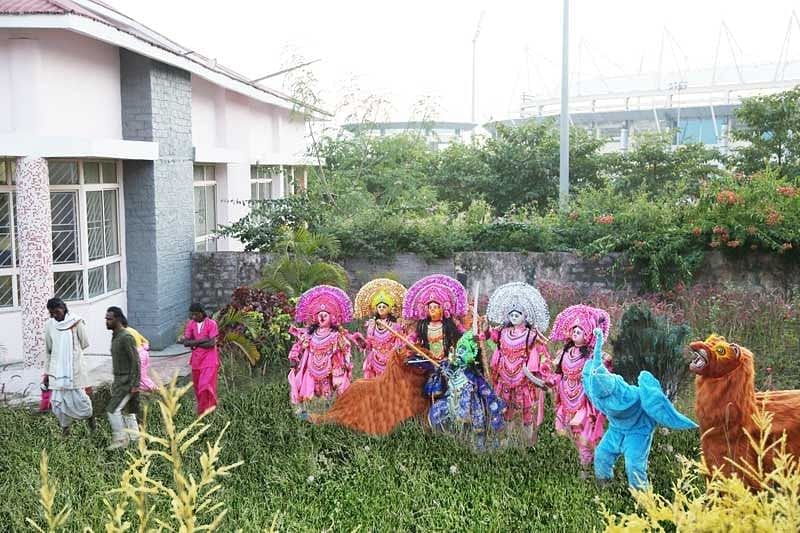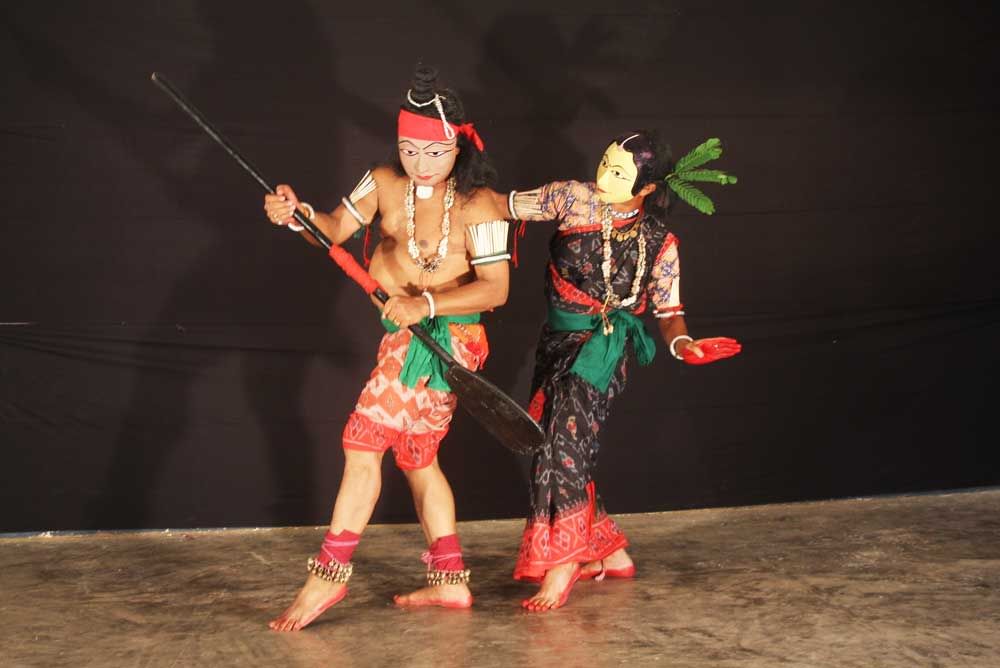JPSC (Jharkhand) Exam > JPSC (Jharkhand) Notes > Jharkhand State (JPSC) PSC: Preparation > Art Institutions of Jharkhand
Art Institutions of Jharkhand | Jharkhand State (JPSC) PSC: Preparation - JPSC (Jharkhand) PDF Download
Audrey House
- Audrey House, constructed by Captain Hailington between 1855 and 1856, is a historic building located in Ranchi, Jharkhand. During the summer months, the office of the Lieutenant Governor of Odisha was transferred to the Governor's House Ranchi, and Audrey House was included as part of this residence.
- A significant historical event associated with Audrey House was the meeting of Mahatma Gandhi with Sir Edward Albert Gat, the then Lieutenant Governor of the United Provinces of Bihar and Orissa (now Odisha), on June 4, 1917. This meeting was held to discuss solutions to the agricultural unrest in the region. The discussions led to the formation of a committee that recommended the abolition of the oppressive system that forced Champaran farmers to grow specific crops and sell their produce under duress. These recommendations were eventually enacted in the Champaran Agricultural Act of 1918.
- Ranchi, the capital of Jharkhand, is situated on the southern part of the Chhotanagpur plateau. Its hilly terrain, combined with lush greenery and natural water sources, made it a favored retreat for British Raj officers and Indian elites. This led to the construction of several institutional and recreational buildings, including Audrey House.
- Audrey House, now a part of the Raj Bhawan (Governor's Residence) of Jharkhand, stands as a significant heritage site. Over its 150-year history, it has witnessed numerous important events and continues to be a prominent landmark in Ranchi.
- Audrey House was built by Captain John Huntington, a British officer, during 1855-56 as an indoor entertainment center. Constructed from wood and tile, it is a notable piece of architecture. When Ranchi served as the summer capital of Bihar, Audrey House functioned as the state secretariat and, prior to the construction of the current Governor's House, also served as the Governor’s Secretariat.
- Today, Audrey House is one of the few surviving heritage buildings in Ranchi. A small portion of it currently houses the State Law Commission's office. Its historical significance and unique architectural value make it an important landmark in the region.
- Originally, during its time as the summer capital of undivided Bihar, Audrey House served as the state secretariat. The Raj Bhavan was established later. Over the years, the building was largely vacant except for a small section used by government departments. It was later reconstructed and repurposed by the Jharkhand government. President Pranab Mukherjee inaugurated it as a center for art and culture.
- The state government, led by Chief Minister Raghubar Das, is expected to follow the recommendation of Governor Draupadi Murmu to rename it as the Mahatma Gandhi Art and Culture Center.
- A century ago, Mahatma Gandhi arrived in Ranchi on July 4, 1917, marking his first visit to the city as part of his effort to organize a mass movement against British rule. He was warmly received by the local community. During his visit, a group of Urav tribals, known as Tana Bhagats, embraced vegetarianism and joined the freedom movement under Gandhi's leadership. They became known for their adherence to white khadi clothing, a vegetarian diet, and their reverence for Gandhi as a spiritual leader.
- Recently, Jharkhand Governor Draupadi Murmu and Chief Minister Raghubar Das commemorated Gandhi's historic visit to Ranchi with an event at Audrey House. The celebration, organized under the BJP government, included a special invitation to the Tana Bhagats, honoring their historical connection to Gandhi and the freedom movement.
Manbhum Chhau Kendra Silli

- Manbhum Chhau is a traditional martial arts dance from Jharkhand, performed by various communities in the region.
- The dance is characterized by its use of heavy masks, bright colorful costumes, and traditional jewelry, all of which contribute to its visually striking and engaging presentation.
- The masks are particularly important as they are used to represent different characters and elements within the performance.
Question for Art Institutions of JharkhandTry yourself: Which traditional martial arts dance is performed in Jharkhand?View Solution
Saraikela Chhau Kendra

- During the days of the Puranas, Singhbhum, which includes Saraikella and Kharsawan, was part of Odisha. Saraikella, a small town on the holy Kharkai River in the south, was once the seat of the Royal Singh Deo family, who were Rajasthani Rajputs that migrated to the region in the seventeenth century. The Simbha Dynasty ruled over the area now known as Singhbhum. The name Singhbhum is contested, with interpretations linking "Sing" to "Sun" and "Bonga" to "God," suggesting a connection to the sun god as the creator of the universe.
- Saraikella and Kharsawan, the twin princely states of British India, were established in 1615 by Raja Kumar Bikram Singh and his descendants. After the Anglo-Maratha War of 1803, Saraikella came under the governance of the Chotanagpur commissioner, while Kharsawan was recognized as a state after 1857. Following independence, they were merged with Odisha and later Bihar, eventually becoming a subdivision. Today, Saraikella-Kharsawan is one of the twenty-four districts of Jharkhand.
- Saraikella is renowned for its rich cultural heritage and is famous for its Chhau Dance. It serves as a cultural hub in Jharkhand, surrounded by lush forests, hillocks, and river belts. The district's administrative structure includes 9 blocks and 136 panchayats.
- Saraikella is renowned as the “Mecca” for music and dance enthusiasts, especially for its world-famous Chhau dance. The region's soil resonates with the rhythm of Chhau, captivating both Indian art lovers and global audiences.
- The Chhau dance is celebrated for its unique charm and grace, depicting themes from mythology, the Mahabharata, nature, daily life, and local folklore. Recognized by UNESCO as part of the Intangible Cultural Heritage of Humanity, Chhau dance showcases a rich blend of traditional storytelling and artistic expression.
- The Chaitra Parva, celebrated annually in April, was initially a religious festival but has evolved into an art festival with spiritual significance. During this festival, people pray to Lord Shiva and Shakti for happiness and prosperity. The celebrations, known as "Chhau Mahotsav," feature Chhau dancing and promote messages of love and harmony.
- In 1960, the state government established the Chhau Dance Centre to promote, propagate, and develop Chhau dance, further supporting the preservation and growth of this unique art form.
- Saraikella, part of the Eastern States Agency, is a small, culturally rich state protected by natural barriers like mountains and streams. This isolation has helped it preserve its cultural and political integrity over time. Notably, Saraikella offers a highly perfected and specialized form of Hindu dance in its purest state.
- The Saraikella dancers represent a unique school of dance that has been meticulously preserved and developed by the local rulers, who have been both patrons and practitioners of the art. Different branches of the ruling family have been dedicated to various dance forms, maintaining an unbroken tradition through generations.
- The Chhau dance synchronizes with the arrival of spring, reflecting cosmic joy and rhythm. It is celebrated annually during Chaitra (March-April) in honor of Lord Shiva. Over three days, both princes and peasants participate in the dance, which draws on themes from nature, the Ramayana, the Mahabharata, and Hindu mythology. The festival features a variety of dance forms with no repetition, and competitions are held with the Maharaja of Saraikella serving as the judge. The winning party receives a flag as a trophy.
- Chhau, derived from the Sanskrit word "Chhaya" meaning shade, is a masked dance. The masks used in Saraikella are exquisitely crafted, evoking moods and aesthetic sentiments (rasa) through intricate lines and colors. These masks are created by skilled artisans, some of whom are trained by their fathers, with even the princesses sometimes participating in their creation.
- Chhau dance, deeply rooted in Saraikella's cultural heritage, has evolved under unique conditions. The dance, which originally developed with a strong focus on maintaining anonymity through masks, emphasizes the skill of the performer rather than their personal identity or appearance. This tradition ensures that the artistry of the dance is paramount.
- The Saraikella Chhau dance is characterized by its male performers, who, despite the absence of female dancers, effectively embody feminine grace and beauty through their movements. This is a testament to the dancers' skill and the dance form's ability to transcend gender.
- The musical accompaniment of Chhau dance is simple yet profound, using traditional instruments like drums, brass cymbals, the flute, and the lyre. These instruments support the dance without overshadowing it, creating a harmonious backdrop that enhances the dance's emotional and thematic expressions.
- Hindu dance, including Chhau, is deeply connected to cosmic rhythms and spiritual practices. It represents the cosmic dance of Shiva, the cosmic actor and dancer. The dance is an artistic representation of the universe's rhythm and life’s various aspects, from creation to destruction. This connection with spiritual and cosmic themes underscores the dance's ritual and worship elements, yet it embraces all that is beautiful in nature and humanity.
- Historically, Hindu dance used gestures and movements to convey stories, emotions, and themes. Chhau dance adheres to this tradition with its own set of gestures and postures, which are meticulously studied and classified. This codified language of dance allows for a rich and expressive performance, where every gesture and movement is meaningful.
- With its transition from a purely ritualistic performance to a recognized art form, Chhau dance has expanded beyond its traditional male-dominated structure. The inclusion of skilled female dancers marks a liberation of the art from social conventions, reflecting the broader acceptance of both male (tandava) and female (lasya) dance forms within Hindu tradition.
- Today, Chhau dance is showcased internationally, maintaining its authenticity and connection to its cultural roots. The dance is presented with the same music and skilled performers, preserving its artistic unity and heritage. It is neither a revival of past traditions nor a compilation of various dance forms but a living art form that continues to be carefully preserved and developed by its practitioners.
The document Art Institutions of Jharkhand | Jharkhand State (JPSC) PSC: Preparation - JPSC (Jharkhand) is a part of the JPSC (Jharkhand) Course Jharkhand State (JPSC) PSC: Preparation.
All you need of JPSC (Jharkhand) at this link: JPSC (Jharkhand)
Related Searches




















